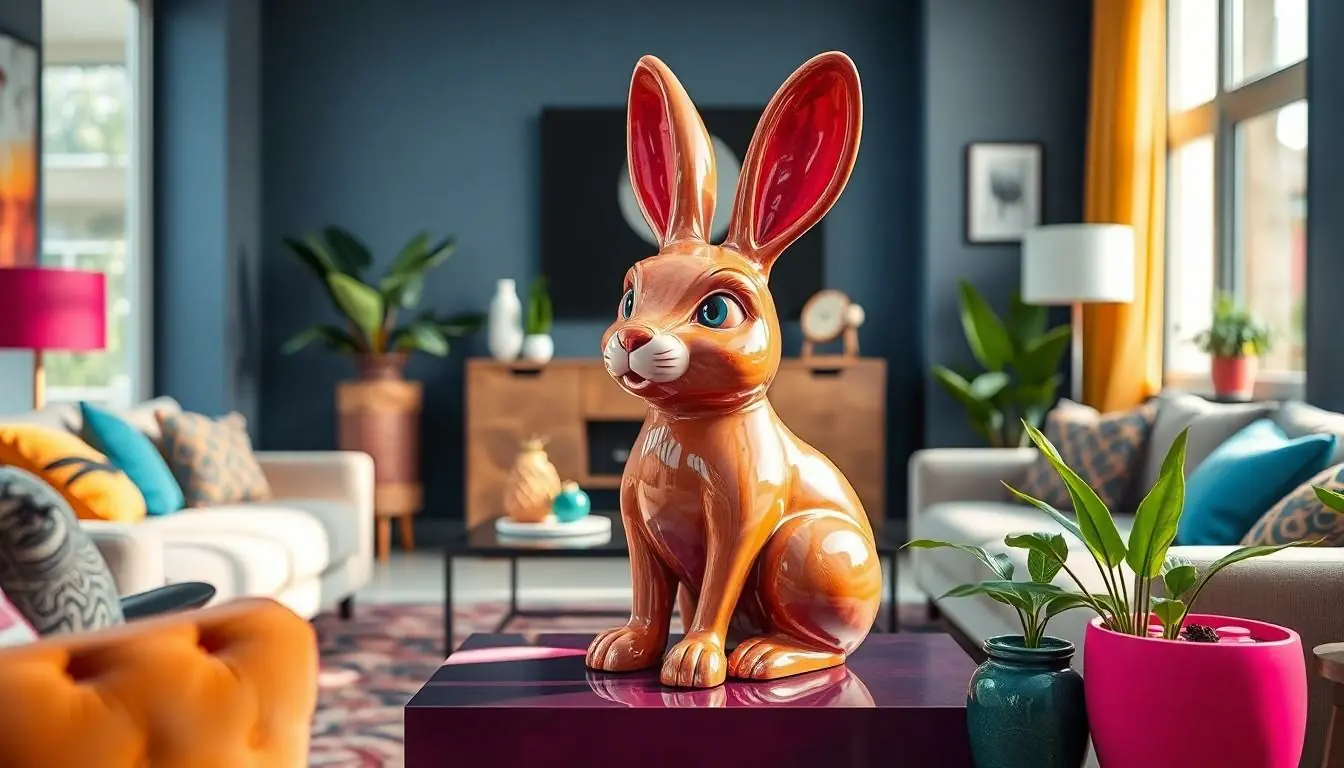Table of Contents
ToggleIn a world filled with ordinary decor, rabbit sculptures hop in to steal the spotlight. These whimsical creations don’t just sit pretty; they bring a playful charm that can transform any space into a conversation starter. Imagine a sleek, modern living room suddenly brightened by a cheeky rabbit statue, winking at guests and inviting smiles.
Whether it’s a serene garden setting or a quirky office nook, rabbit sculptures add a dash of personality that’s hard to resist. They’re not just for bunny lovers; they appeal to anyone who appreciates art that’s both fun and sophisticated. So, if you’re ready to elevate your decor game, let’s dive into the enchanting world of rabbit sculptures and discover why these fluffy figures are hopping their way into hearts and homes everywhere.
Overview of Rabbit Sculpture
Rabbit sculptures serve as captivating artistic expressions that adorn various environments. These pieces vary in style, size, and material, appealing to collectors and casual observers alike. From intricate porcelain figures to life-sized outdoor installations, the diversity of rabbit sculptures is vast.
Artists frequently draw inspiration from rabbits’ symbolization of fertility, rebirth, and playfulness. The whimsical nature of these sculptures often evokes joy, whether displayed in gardens, homes, or galleries. Craftsmanship plays a crucial role in their appeal; detailed features and creative designs attract attention and admiration.
Many homeowners incorporate rabbit sculptures as focal points in their decor. Placement in gardens encourages a sense of whimsy, while indoor versions can complement both modern and traditional settings. Sculptures in vibrant colors invite engagement, while those in neutral tones provide subtle elegance.
Collectors also appreciate the investment potential of rabbit sculptures. Limited editions and unique artist renditions can appreciate over time, making them desirable. Auctions and galleries showcase prominent pieces that attract serious bids, further elevating their status in the art world.
Local artisans contribute to the rabbit sculpture trend by creating handmade pieces that reflect personal styles and regional influences. The rise of online marketplaces allows these artists to reach a broader audience, increasing the visibility of their work.
Rabbit sculptures enjoy a prominent place in contemporary art scenes, blending traditional forms with innovative concepts. They challenge perceptions of sculpture, encouraging dialogue about the role of animals in art. Overall, rabbit sculptures combine aesthetic pleasure with deep cultural significance, appealing to a wide range of enthusiasts.
History of Rabbit Sculpture

Rabbit sculptures date back to ancient times, often embodying various cultural meanings. These representations reveal the significance of rabbits in different civilizations.
Ancient Representations
Ancient Egyptian art frequently showcased rabbit imagery, linking the animal to fertility and rebirth. In Chinese culture, rabbits symbolize good luck and prosperity, leading to their depiction in various forms of art. Ancient Greeks also featured rabbits in pottery, reflecting their connection to nature and agriculture. These early artworks illustrate deep-rooted beliefs tied to the rabbit, making it a prevalent subject across diverse historical contexts.
Modern Interpretations
Contemporary rabbit sculptures embrace a variety of styles and materials, reflecting current artistic trends. Artists utilize mediums such as metal, wood, and ceramics to create unique pieces that resonate with modern audiences. Playful designs often incorporate whimsical elements, inviting interaction and enjoyment. Galleries and public installations increasingly feature these works, highlighting the rabbit’s enduring allure. Recent creations also explore themes of environmentalism and identity, further broadening the scope of rabbit art today.
Materials Used in Rabbit Sculpture
Rabbit sculptures exhibit a wide range of materials, each contributing unique characteristics to the final piece. Artists select specific mediums based on aesthetic preferences and the desired message.
Wood
Selected for its warmth and versatility, wood offers a natural feel in rabbit sculptures. Artists often utilize various species such as oak, maple, and pine. Each type brings distinct grain patterns and colors, enhancing visual appeal. Wood sculptures may feature intricate carvings that showcase craftsmanship. Finishing techniques, including staining or painting, add depth to the artwork, allowing for customization.
Stone
Stone serves as a durable option for rabbit sculptures, providing a sense of permanence. Common varieties include marble, granite, and soapstone, each celebrated for unique textures and colors. Artists shape stone by carving or polishing, highlighting its natural beauty. Sculpture made from stone often conveys elegance and sophistication, making it a popular choice for outdoor settings. The weight of stone creates stability, making these pieces less prone to damage.
Metal
Metal lends a contemporary touch to rabbit sculptures, appealing to modern aesthetics. Artists frequently use materials such as bronze, aluminum, and steel for their durability and ability to hold intricate forms. Metalworks can feature patinas or painted finishes, allowing for diverse expressions of color and texture. Some sculptures incorporate mixed media elements, further enhancing creativity. The reflective qualities of metal can create dynamic interactions with light, adding to the captivating nature of the piece.
Famous Rabbit Sculptors
Rabbit sculpture attracts attention from numerous talented artists, each bringing unique styles and perspectives. Their contributions significantly shape the art world while celebrating the charm of these whimsical creatures.
Notable Works
Notable works include pieces by renowned sculptor Jeff Koons, whose playful designs elevate the rabbit’s status in contemporary art. Additionally, artist Franz Xaver Messerschmidt created the famous “Rabbit” sculpture, showcasing exquisite detail and craftsmanship. Other remarkable examples come from local artisans who create bespoke, handmade rabbit sculptures, enriching local art scenes and resonating with collectors.
Influence on the Art Community
Influence within the art community continues to grow as rabbit sculptures encourage discussions about symbolism, nature, and identity. Artists often use these sculptures to challenge conventions, attracting attention in galleries and public installations. Moreover, the playful nature of rabbit sculptures inspires younger artists, instilling a sense of creativity and exploration in animal representation within contemporary art.
The Symbolism of Rabbit in Art
Rabbit symbolism in art carries rich meanings across cultures. Various interpretations often highlight fertility, abundance, and renewal. In ancient Egypt, artists associated rabbits with fertility and rebirth, creating connections between life cycles and the natural world. Associations with good luck appear in Chinese traditions, where rabbits symbolize prosperity, particularly in lunar New Year celebrations.
Artistic representations frequently emphasize playfulness. This element enhances the visual impact of rabbit sculptures and invites personal reflections. Myths and folklore often feature rabbits as clever tricksters, further enriching their symbolic qualities. In Western cultures, these attributes permeate literature and popular culture, reinforcing the idea of the rabbit as a charming and joyous figure.
Contemporary artists draw inspiration from these traditional connotations. They often blend historical significance with modern themes, exploring identity, environmentalism, and human emotions. Material choices significantly influence the symbols conveyed, such as lightness in wood or durability in stone, allowing for diverse interpretations and experiences.
Exhibition spaces also play a crucial role in shaping rabbit symbolism. Public art installations often provoke thought about the relationship between nature and urbanized environments. Viewers engage with these artworks, reflecting on their meanings and cultural contexts. This engagement fosters deeper appreciation and dialogue surrounding the artistic representation of rabbits.
Rabbit sculptures embody multifaceted symbolism in the art world. From ancient times to current creations, they interact with cultural beliefs and inspire personal connections. Artists explore the essence of rabbits as symbols of joy, fertility, and change, showcasing their enduring relevance in contemporary art.
Rabbit sculptures are more than just decorative pieces; they embody a rich tapestry of cultural significance and artistic expression. Their playful designs and varied materials invite admiration and spark conversations in any setting. As they continue to gain popularity, these sculptures resonate with both collectors and casual art lovers alike.
The fusion of tradition and modernity in rabbit sculptures reflects evolving artistic trends and themes. Whether displayed in gardens or homes, they bring a sense of joy and whimsy that enhances the environment. With their deep-rooted symbolism and captivating craftsmanship, rabbit sculptures are sure to remain cherished elements in the world of art and decor.




